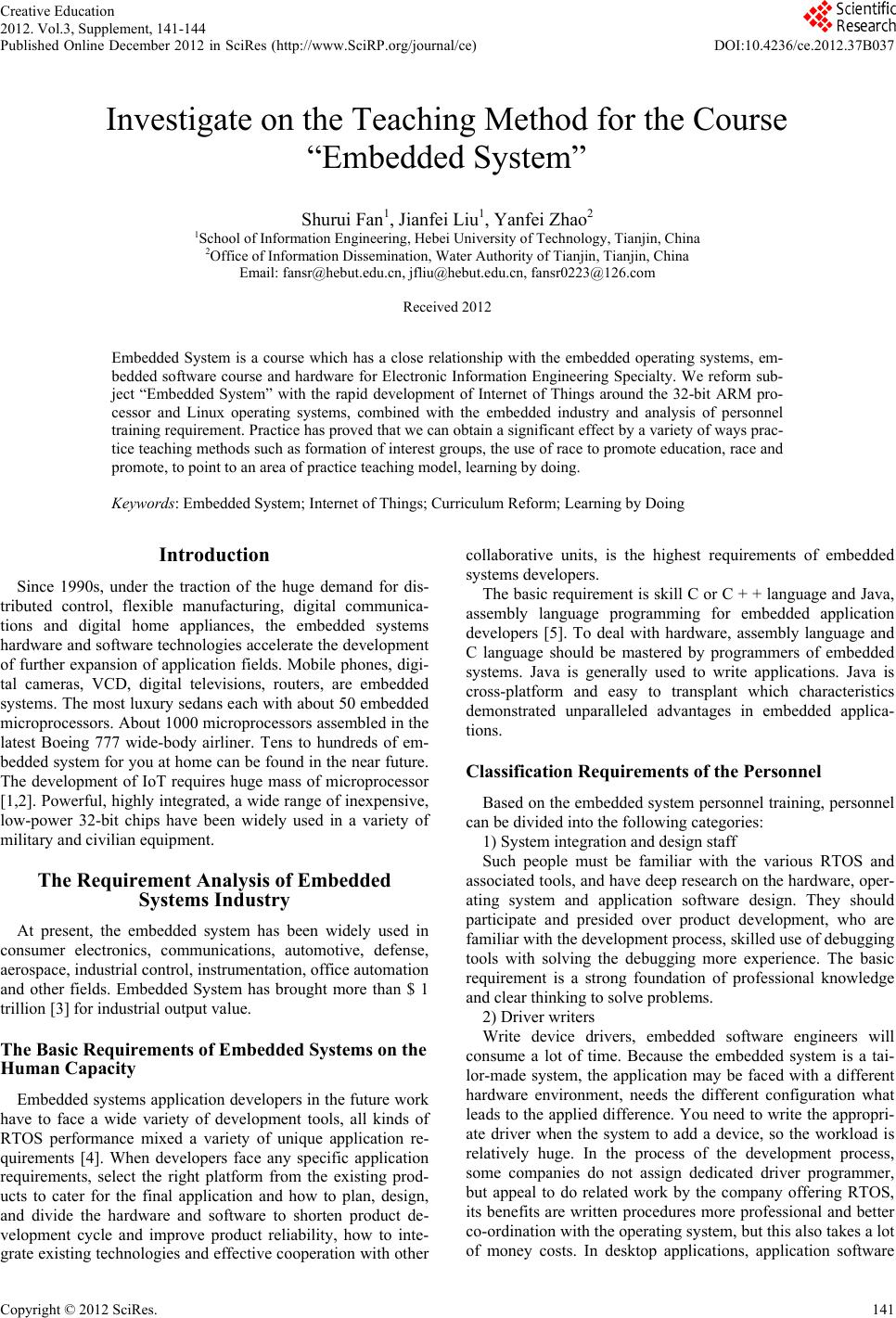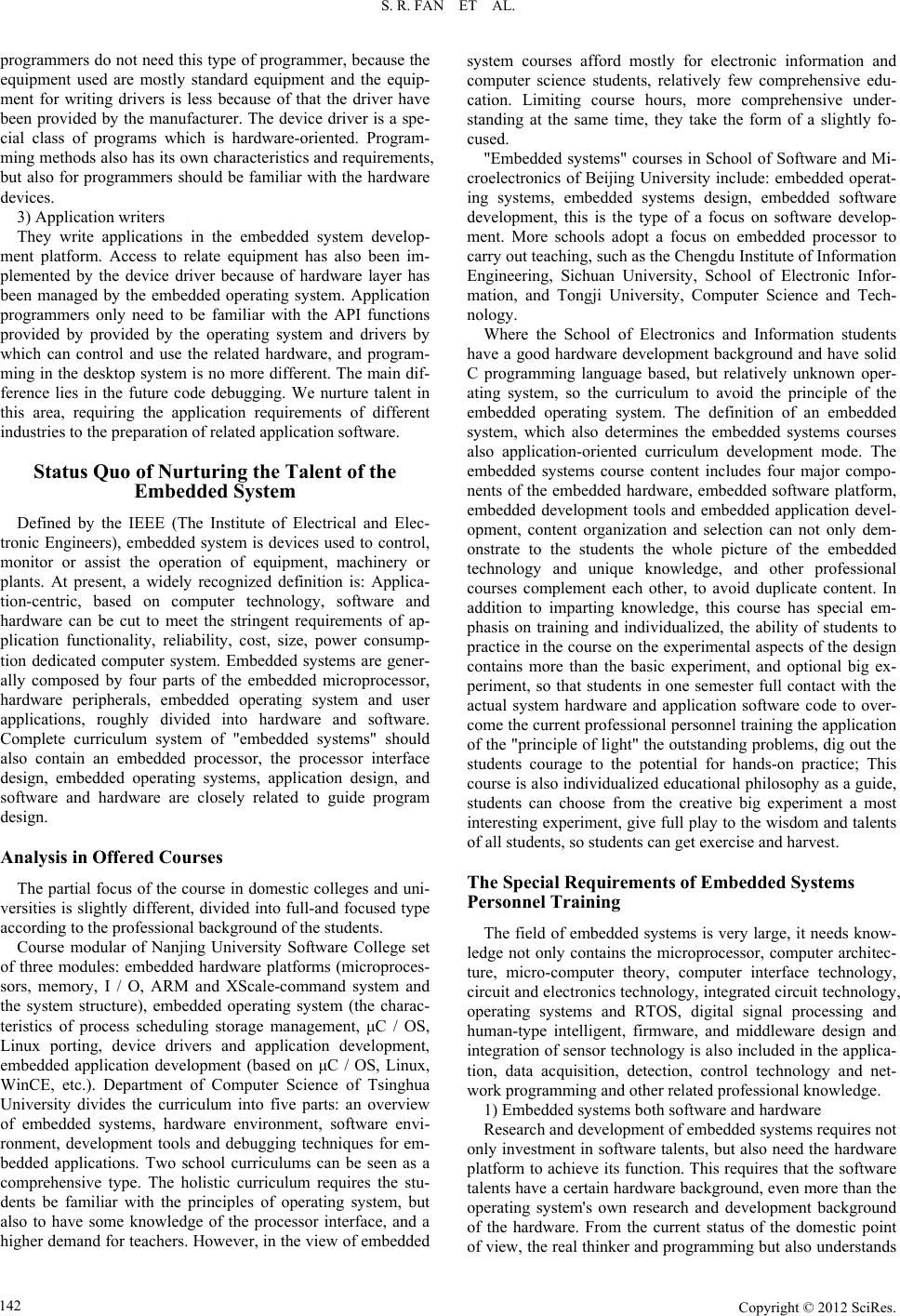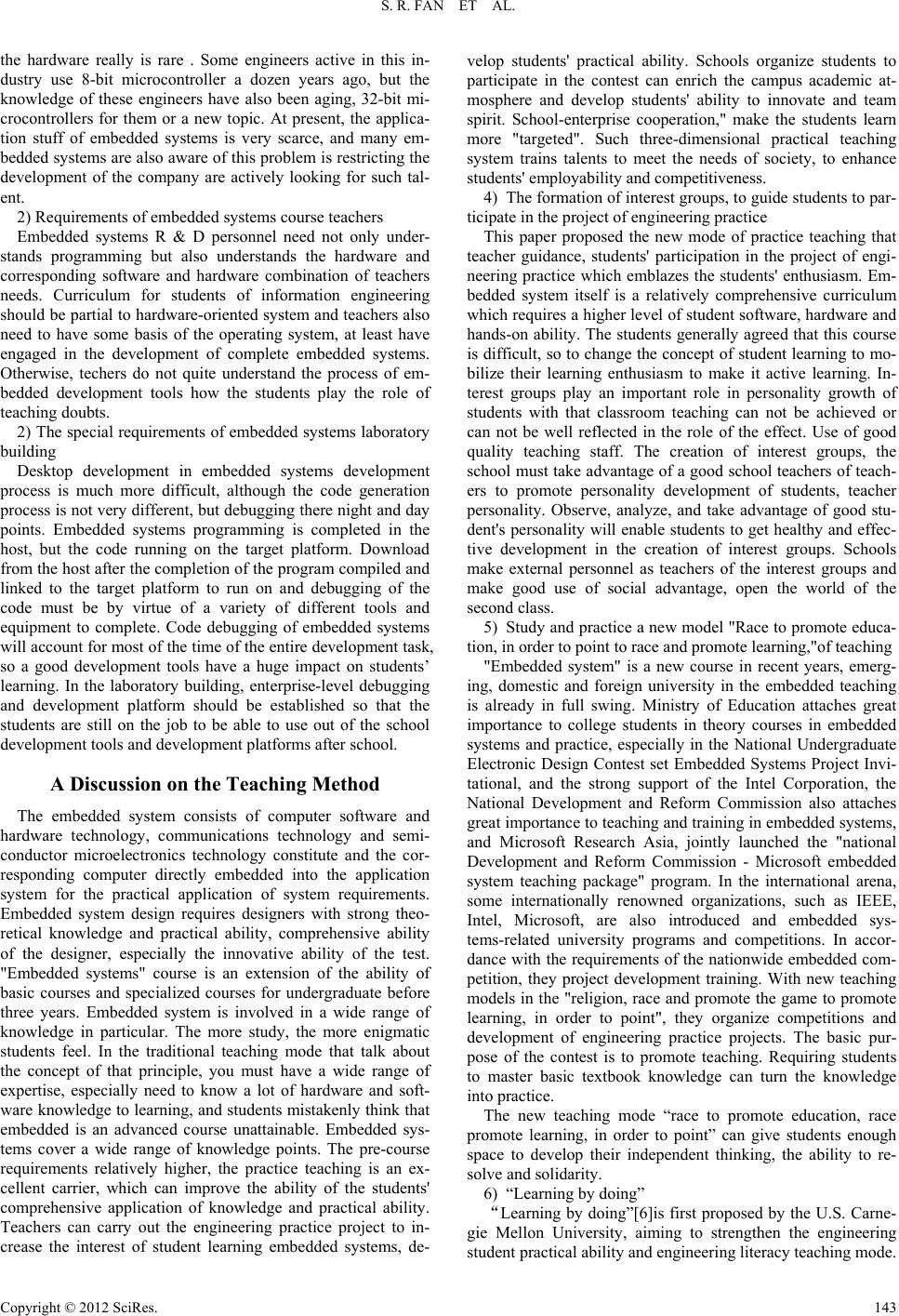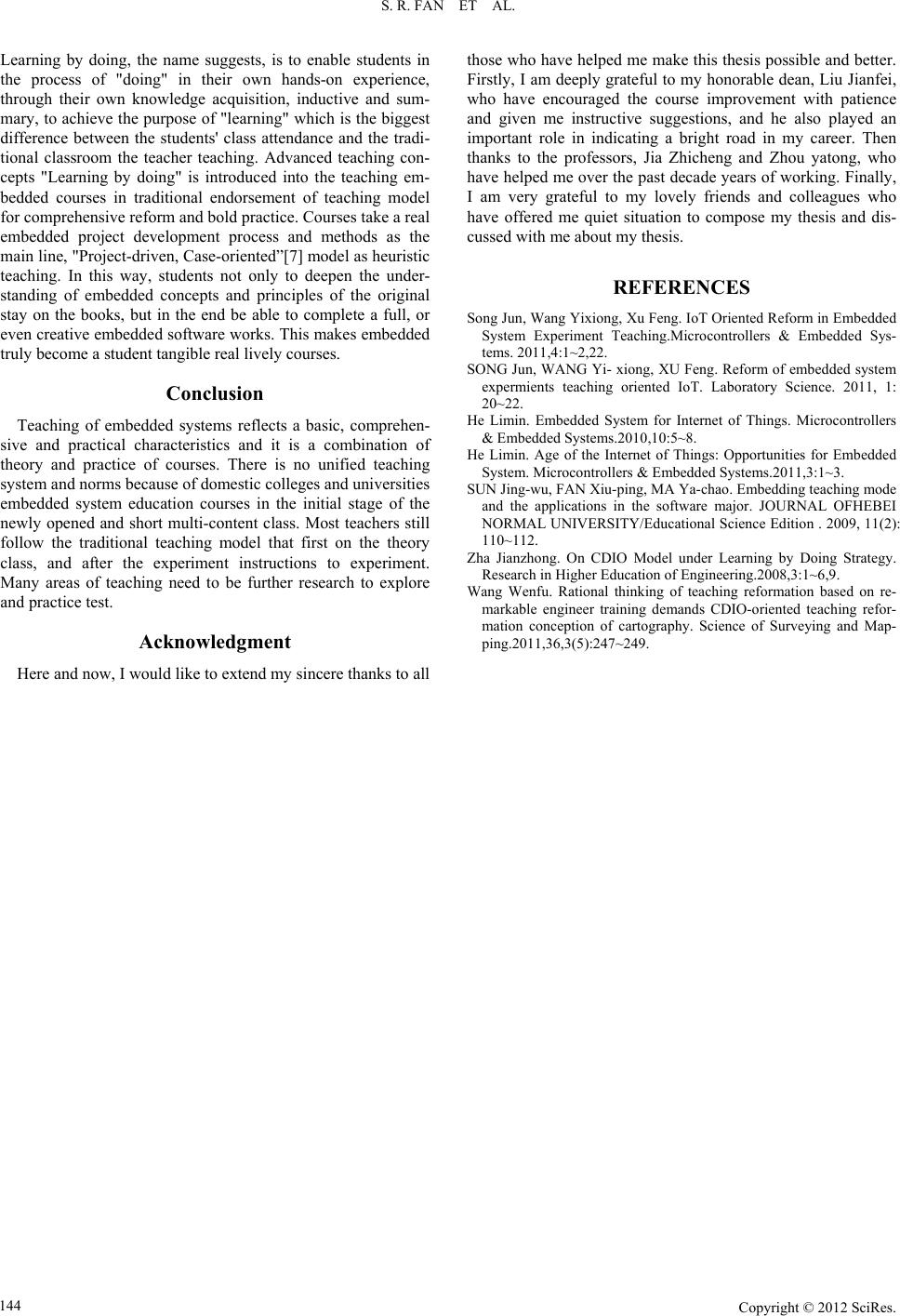Paper Menu >>
Journal Menu >>
 Creative Education 2012. Vol.3, Supplement, 141-144 Published Online December 2012 in SciRes (http://www.SciRP.org/journal/ce) DOI:10.4236/ce.2012.37B037 Copyright © 2012 SciRes. 141 Investigate on the Teaching Method for the Course “Embedded System” Shurui Fan1, Jianfei Liu1, Yanfei Zhao2 1School of Information Engineering, Hebei University of Technology, Tianjin, China 2Office of Information Dissemination, Water Authority of Tianjin, Tianjin, China Email: fansr@hebut.edu.cn, jfliu@hebut.edu.cn, fansr0223@126.com Received 2012 Embedded System is a course which has a close relationship with the embedded operating systems, em- bedded software course and hardware for Electronic Information Engineering Specialty. We reform sub- ject “Embedded System” with the rapid development of Internet of Things around the 32-bit ARM pro- cessor and Linux operating systems, combined with the embedded industry and analysis of personnel training requirement. Practice has proved that we can obtain a significant effect by a variety of ways prac- tice teaching methods such as formation of interest groups, the use of race to promote education, race and promote, to point to an area of practice teaching model, learning by doing. Keywords: Embedded System; Internet of Things; Curriculum Reform; Learning by Doing Introduction Since 1990s, under the traction of the huge demand for dis- tributed control, flexible manufacturing, digital communica- tions and digital home appliances, the embedded systems hardware and software technologies accelerate the development of further expansion of application fields. Mobile phones, digi- tal cameras, VCD, digital televisions, routers, are embedded systems. The most luxury sedans each with about 50 embedded microprocessors. About 1000 microprocessors assembled in the latest Boeing 777 wide-body airliner. Tens to hundreds of em- bedded system for you at home can be found in the near future. The development of IoT requires huge mass of microprocessor [1,2]. Powerful, highly integrated, a wide range of inexpensive, low-power 32-bit chips have been widely used in a variety of military and civilian equipment. The Requirement Analysis of Embedded Systems Industry At present, the embedded system has been widely used in consumer electronics, communications, automotive, defense, aerospace, industrial control, instrumentation, office automation and other fields. Embedded System has brought more than $ 1 trillion [3] for industrial output value. The Basic Requirements of Embedded Systems on the Human Capacity Embedded systems application developers in the future work have to face a wide variety of development tools, all kinds of RTOS performance mixed a variety of unique application re- quirements [4]. When developers face any specific application requirements, select the right platform from the existing prod- ucts to cater for the final application and how to plan, design, and divide the hardware and software to shorten product de- velopment cycle and improve product reliability, how to inte- grate existing technologies and effective cooperation with other collaborative units, is the highest requirements of embedded systems developers. The basic requirement is skill C or C + + language and Java, assembly language programming for embedded application developers [5]. To deal with hardware, assembly language and C language should be mastered by programmers of embedded systems. Java is generally used to write applications. Java is cross-platform and easy to transplant which characteristics demonstrated unparalleled advantages in embedded applica- tions. Classification Requirements of the Personnel Based on the embedded system personnel training, personnel can be divided into the following categories: 1) System integration and design staff Such people must be familiar with the various RTOS and associated tools, and have deep research on the hardware, oper- ating system and application software design. They should participate and presided over product development, who are familiar with the development process, skilled use of debugging tools with solving the debugging more experience. The basic requirement is a strong foundation of professional knowledge and clear thinking to solve problems. 2) Driver writers Write device drivers, embedded software engineers will consume a lot of time. Because the embedded system is a tai- lor-made system, the application may be faced with a different hardware environment, needs the different configuration what leads to the applied difference. You need to write the appropri- ate driver when the system to add a device, so the workload is relatively huge. In the process of the development process, some companies do not assign dedicated driver programmer, but appeal to do related work by the company offering RTOS, its benefits are written procedures more professional and better co-ordination with the operating system, but this also takes a lot of money costs. In desktop applications, application software  S. R. FAN ET AL. Copyright © 2012 SciRes. 142 programmers do not need this type of programmer, because the equipment used are mostly standard equipment and the equip- ment for writing drivers is less because of that the driver have been provided by the manufacturer. The device driver is a spe- cial class of programs which is hardware-oriented. Program- ming methods also has its own characteristics and requirements, but also for programmers should be familiar with the hardware devices. 3) Application writers They write applications in the embedded system develop- ment platform. Access to relate equipment has also been im- plemented by the device driver because of hardware layer has been managed by the embedded operating system. Application programmers only need to be familiar with the API functions provided by provided by the operating system and drivers by which can control and use the related hardware, and program- ming in the desktop system is no more different. The main dif- ference lies in the future code debugging. We nurture talent in this area, requiring the application requirements of different industries to the preparation of related application software. Status Quo of Nurturing the Talent of the Embedded System Defined by the IEEE (The Institute of Electrical and Elec- tronic Engineers), embedded system is devices used to control, monitor or assist the operation of equipment, machinery or plants. At present, a widely recognized definition is: Applica- tion-centric, based on computer technology, software and hardware can be cut to meet the stringent requirements of ap- plication functionality, reliability, cost, size, power consump- tion dedicated computer system. Embedded systems are gener- ally composed by four parts of the embedded microprocessor, hardware peripherals, embedded operating system and user applications, roughly divided into hardware and software. Complete curriculum system of "embedded systems" should also contain an embedded processor, the processor interface design, embedded operating systems, application design, and software and hardware are closely related to guide program design. Analy sis in Offered Courses The partial focus of the course in domestic colleges and uni- versities is slightly different, divided into full-and focused type according to the professional background of the students. Course modular of Nanjing University Software College set of three modules: embedded hardware platforms (microproces- sors, memory, I / O, ARM and XScale-command system and the system structure), embedded operating system (the charac- teristics of process scheduling storage management, μC / OS, Linux porting, device drivers and application development, embedded application development (based on μC / OS, Linux, WinCE, etc.). Department of Computer Science of Tsinghua University divides the curriculum into five parts: an overview of embedded systems, hardware environment, software envi- ronment, development tools and debugging techniques for em- bedded applications. Two school curriculums can be seen as a comprehensive type. The holistic curriculum requires the stu- dents be familiar with the principles of operating system, but also to have some knowledge of the processor interface, and a higher demand for teachers. However, in the view of embedded system courses afford mostly for electronic information and computer science students, relatively few comprehensive edu- cation. Limiting course hours, more comprehensive under- standing at the same time, they take the form of a slightly fo- cused. "Embedded systems" courses in School of Software and Mi- croelectronics of Beijing University include: embedded operat- ing systems, embedded systems design, embedded software development, this is the type of a focus on software develop- ment. More schools adopt a focus on embedded processor to carry out teaching, such as the Chengdu Institute of Information Engineering, Sichuan University, School of Electronic Infor- mation, and Tongji University, Computer Science and Tech- nology. Where the School of Electronics and Information students have a good hardware development background and have solid C programming language based, but relatively unknown oper- ating system, so the curriculum to avoid the principle of the embedded operating system. The definition of an embedded system, which also determines the embedded systems courses also application-oriented curriculum development mode. The embedded systems course content includes four major compo- nents of the embedded hardware, embedded software platform, embedded development tools and embedded application devel- opment, content organization and selection can not only dem- onstrate to the students the whole picture of the embedded technology and unique knowledge, and other professional courses complement each other, to avoid duplicate content. In addition to imparting knowledge, this course has special em- phasis on training and individualized, the ability of students to practice in the course on the experimental aspects of the design contains more than the basic experiment, and optional big ex- periment, so that students in one semester full contact with the actual system hardware and application software code to over- come the current professional personnel training the application of the "principle of light" the outstanding problems, dig out the students courage to the potential for hands-on practice; This course is also individualized educational philosophy as a guide, students can choose from the creative big experiment a most interesting experiment, give full play to the wisdom and talents of all students, so students can get exercise and harvest. The Special Requirements of Embedded Systems Personnel Training The field of embedded systems is very large, it needs know- ledge not only contains the microprocessor, computer architec- ture, micro-computer theory, computer interface technology, circuit and electronics technology, integrated circuit technology, operating systems and RTOS, digital signal processing and human-type intelligent, firmware, and middleware design and integration of sensor technology is also included in the applica- tion, data acquisition, detection, control technology and net- work programming and other related professional knowledge. 1) Embedded systems both software and hardware Research and development of embedded systems requires not only investment in software talents, but also need the hardware platform to achieve its function. This requires that the software talents have a certain hardware background, even more than the operating system's own research and development background of the hardware. From the current status of the domestic point of view, the real thinker and programming but also understands  S. R. FAN ET AL. Copyright © 2012 SciRes. 143 the hardware really is rare . Some engineers active in this in- dustry use 8-bit microcontroller a dozen years ago, but the knowledge of these engineers have also been aging, 32-bit mi- crocontrollers for them or a new topic. At present, the applica- tion stuff of embedded systems is very scarce, and many em- bedded systems are also aware of this problem is restricting the development of the company are actively looking for such tal- ent. 2) Requirements of embedded systems course teachers Embedded systems R & D personnel need not only under- stands programming but also understands the hardware and corresponding software and hardware combination of teachers needs. Curriculum for students of information engineering should be partial to hardware-oriented system and teachers also need to have some basis of the operating system, at least have engaged in the development of complete embedded systems. Otherwise, techers do not quite understand the process of em- bedded development tools how the students play the role of teaching doubts. 2) The special requirements of embedded systems laboratory building Desktop development in embedded systems development process is much more difficult, although the code generation process is not very different, but debugging there night and day points. Embedded systems programming is completed in the host, but the code running on the target platform. Download from the host after the completion of the program compiled and linked to the target platform to run on and debugging of the code must be by virtue of a variety of different tools and equipment to complete. Code debugging of embedded systems will account for most of the time of the entire development task, so a good development tools have a huge impact on students’ learning. In the laboratory building, enterprise-level debugging and development platform should be established so that the students are still on the job to be able to use out of the school development tools and development platforms after school. A Discussion on the Teaching Meth od The embedded system consists of computer software and hardware technology, communications technology and semi- conductor microelectronics technology constitute and the cor- responding computer directly embedded into the application system for the practical application of system requirements. Embedded system design requires designers with strong theo- retical knowledge and practical ability, comprehensive ability of the designer, especially the innovative ability of the test. "Embedded systems" course is an extension of the ability of basic courses and specialized courses for undergraduate before three years. Embedded system is involved in a wide range of knowledge in particular. The more study, the more enigmatic students feel. In the traditional teaching mode that talk about the concept of that principle, you must have a wide range of expertise, especially need to know a lot of hardware and soft- ware knowledge to learning, and students mistakenly think that embedded is an advanced course unattainable. Embedded sys- tems cover a wide range of knowledge points. The pre-course requirements relatively higher, the practice teaching is an ex- cellent carrier, which can improve the ability of the students' comprehensive application of knowledge and practical ability. Teachers can carry out the engineering practice project to in- crease the interest of student learning embedded systems, de- velop students' practical ability. Schools organize students to participate in the contest can enrich the campus academic at- mosphere and develop students' ability to innovate and team spirit. School-enterprise cooperation," make the students learn more "targeted". Such three-dimensional practical teaching system trains talents to meet the needs of society, to enhance students' employability and competitiveness. 4) T he formation of interest groups, to guide students to par- ticipate in the project of engineering practice This paper proposed the new mode of practice teaching that teacher guidance, students' participation in the project of engi- neering practice which emblazes the students' enthusiasm. Em- bedded system itself is a relatively comprehensive curriculum which requires a higher level of student software, hardware and hands-on ability. The students generally agreed that this course is difficult, so to change the concept of student learning to mo- bilize their learning enthusiasm to make it active learning. In- terest groups play an important role in personality growth of students with that classroom teaching can not be achieved or can not be well reflected in the role of the effect. Use of good quality teaching staff. The creation of interest groups, the school must take advantage of a good school teachers of teach- ers to promote personality development of students, teacher personality. Observe, analyze, and take advantage of good stu- dent's personality will enable students to get healthy and effec- tive development in the creation of interest groups. Schools make external personnel as teachers of the interest groups and make good use of social advantage, open the world of the second class. 5) Study a nd practice a new model "Race to promote educa- tion, in order to point to race and promote learning,"of teaching "Embedded system" is a new course in recent years, emerg- ing, domestic and foreign university in the embedded teaching is already in full swing. Ministry of Education attaches great importance to college students in theory courses in embedded systems and practice, especially in the National Undergraduate Electronic Design Contest set Embedded Systems Project Invi- tational, and the strong support of the Intel Corporation, the National Development and Reform Commission also attaches great importance to teaching and training in embedded systems, and Microsoft Research Asia, jointly launched the "national Development and Reform Commission - Microsoft embedded system teaching package" program. In the international arena, some internationally renowned organizations, such as IEEE, Intel, Microsoft, are also introduced and embedded sys- tems-related university programs and competitions. In accor- dance with the requirements of the nationwide embedded com- petition, they project development training. With new teaching models in the "religion, race and promote the game to promote learning, in order to point", they organize competitions and development of engineering practice projects. The basic pur- pose of the contest is to promote teaching. Requiring students to master basic textbook knowledge can turn the knowledge into practice. The new teaching mode “race to promote education, race promote learning, in order to point” can give students enough space to develop their independent thinking, the ability to re- solve and solidarity. 6) “Lea rni ng by doing” “Learning by doing”[6]is first proposed by the U.S. Carne- gie Mellon University, aiming to strengthen the engineering student practical ability and engineering literacy teaching mode.  S. R. FAN ET AL. Copyright © 2012 SciRes. 144 Learning by doing, the name suggests, is to enable students in the process of "doing" in their own hands-on experience, through their own knowledge acquisition, inductive and sum- mary, to achieve the purpose of "learning" which is the biggest difference between the students' class attendance and the tradi- tional classroom the teacher teaching. Advanced teaching con- cepts "Learning by doing" is introduced into the teaching em- bedded courses in traditional endorsement of teaching model for comprehensive reform and bold practice. Courses take a real embedded project development process and methods as the main line, "Project-driven, Case-oriented”[7] model as heuristic teaching. In this way, students not only to deepen the under- standing of embedded concepts and principles of the original stay on the books, but in the end be able to complete a full, or even creative embedded software works. This makes embedded truly become a student tangible real lively courses. Conclusion Teaching of embedded systems reflects a basic, comprehen- sive and practical characteristics and it is a combination of theory and practice of courses. There is no unified teaching system and norms because of domestic colleges and universities embedded system education courses in the initial stage of the newly opened and short multi-content class. Most teachers still follow the traditional teaching model that first on the theory class, and after the experiment instructions to experiment. Many areas of teaching need to be further research to explore and prac tice test. Acknowledgment Here and now, I would like to extend my sincere thanks to all those who have helped me make this thesis possible and better. Firstly, I am deeply grateful to my honorable dean, Liu Jianfei, who have encouraged the course improvement with patience and given me instructive suggestions, and he also played an important role in indicating a bright road in my career. Then thanks to the professors, Jia Zhicheng and Zhou yatong, who have helped me over the past decade years of working. Finally, I am very grateful to my lovely friends and colleagues who have offered me quiet situation to compose my thesis and dis- cussed with me about my thesis. REFERENCES Song Jun, Wang Yixiong, Xu Feng. IoT Oriented Reform in Embedded System Experiment Teaching.Microcontrollers & Embedded Sys- tems. 2011,4:1~2,22. SONG Jun, WANG Yi- xiong, XU Feng. Reform of embedded system expermients teaching oriented IoT. Laboratory Science. 2011, 1: 20~22. He Limin. Embedded System for Internet of Things. Microcontrollers & Embedded Systems.2010,10:5~ 8. He Limin. Age of the Internet of Things: Opportunities for Embedded System. Microcontrollers & Embedded Systems.2011,3:1~3. SUN Jing-wu, FAN Xiu -pin g, MA Ya-chao. Embedding teaching mode and the applications in the software major. JOURNAL OFHEBEI NORMAL UNIVERSITY/Educatio nal Science Edition . 2009, 11(2): 110~112. Zha Jianzhong. On CDIO Model under Learning by Doing Strategy. Research in Higher Education of E ngineering.2008,3:1~6,9. Wang Wenfu. Rational thinking of teaching reformation based on re- markable engineer training demands CDIO-oriented teaching refor- mation conception of cartography. Science of Surveying and Map- ping.2011,36,3(5):247~249. |

